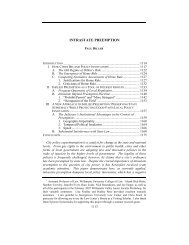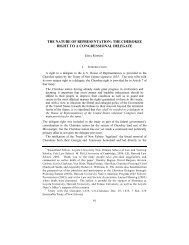THE NATO BOMBING CASE (BANKOVIC ET AL. V. BELGIUM ET AL ...
THE NATO BOMBING CASE (BANKOVIC ET AL. V. BELGIUM ET AL ...
THE NATO BOMBING CASE (BANKOVIC ET AL. V. BELGIUM ET AL ...
Create successful ePaper yourself
Turn your PDF publications into a flip-book with our unique Google optimized e-Paper software.
2005]<strong>THE</strong> <strong>NATO</strong> <strong>BOMBING</strong> <strong>CASE</strong> AND HUMAN RIGHTS PROTECTION 59would bomb an unfriendly television station in territory controlled byinsurgents).The respondent governments argued that Article 1 had to be interpretedin accordance with what they professed to be its “ordinary meaning”in public international law. 13 In their arguments before the Court,they maintained that the term “jurisdiction” in Article 1 referred to the“assertion or exercise of legal authority, actual or purported, over personsowing some form of allegiance to that State or who have beenbrought within that State’s control.” 14 Furthermore, the respondent governmentsargued that the term “generally entails some form of structuredrelationship normally existing over a period of time.” 15 Thus, accordingto the respondent governments, although a Contracting State’s obligationsunder the Convention extend equally to all individuals within itsterritory, its obligations to persons outside of its recognized borders arelimited to individuals who have some kind of pre-existing relationshipwith the Contracting State. 16 Because such a relationship did not existbetween the applicants and the respondent states, their claims were inadmissibleratione personae (because of the person’s character). 17This proposition should give pause, at least if one assumes that theConvention protects human rights and that human rights rest on a foundationalcommitment to the equal dignity of every human being. Surprisingly,however, the Court’s opinion closely tracks the rationales of therespondent governments.The Court began its opinion by defining the question before it, firstobserving that “the real connection between the applicants and therespondent States is the impugned act which, wherever decided, was performed,or had effects, outside of the territory of those States (“the extraterritorialact”), 18 and then proceeding to question “whether the applicantsand their deceased relatives were, as a result of that extra-territorialact, capable of falling within the jurisdiction of the respondent States.” 19In answering this question, the Court ruled “As to the ‘ordinary meaning’of the relevant term [jurisdiction] in Article 1 of the Convention, theCourt is satisfied that, from the standpoint of public international law, thejurisdictional competence of a State is primarily territorial.” 20To support the contention that this was indeed the “ordinary meaning”of the term in international law, the Court pointed to usage among inter-13 Bankovic v. Belgium, 36.14 Id.15 Id.16 Id. 35-45.17 Id. 45.18 Id. 54.19 Bankovic v. Belgium, 54.20 Id. 59.









